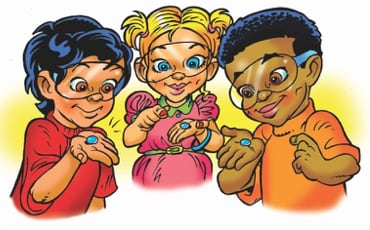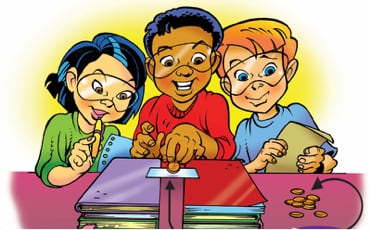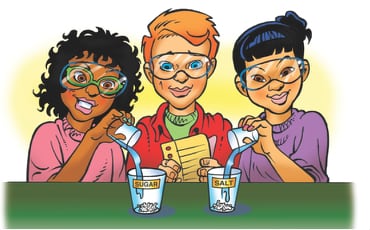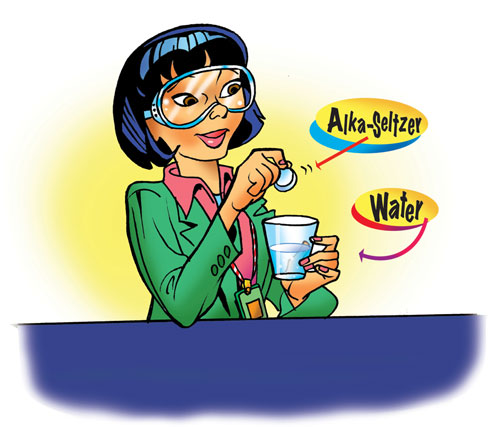Lesson Overview for Teachers
View the video below to see what you and your students will do in this lesson.
Downloadables:
Lesson Plan (PDF) | Teacher Background (PDF) | Connections to NGSS (PDF)
Objective
Students will be able to explain that clouds are made up of tiny droplets of water. They will also be able to make a model to explain that these water droplets come together to form larger drops that fall from clouds as rain.
Key Concepts
- Rain comes from tiny water droplets in clouds.
- As the number of water droplets increases, they join together to make larger drops thatfall as rain.
Note: How the water gets up into the cloud initially (evaporation and condensation) is investigated in the next lesson (Lesson 1.2).
NGSS Alignment
- K-ESS2-1: Use and share observations of local weather conditions to describe patterns over time.
The activities in this lesson focus on what a cloud is and what makes it rain. Students will understand the connection between clouds and rain and recognize the pattern that clouds are necessary for rain.
Summary
- Students watch a video of rain falling and have a class discussion about the importance of rain and how we use water in our daily lives.
- Students put tiny drops of water on a laminated picture to make a model of a cloud.
- Students stand the card up and the drops stay in the cloud but when they make the drops bigger, they fall as rain.
- Students see an animation showing that clouds are made of tiny water droplets and that these droplets come together to make bigger drops that fall as rain.
- Students model this process using clay or Play-Doh to represent tiny droplets in a cloud.
Evaluation
There is no formal student activity sheet or assessment for this lesson. To evaluate student understanding, use your usual methods of interacting with students, asking questions, and discussing ideas with students as they participate in the different parts of the lesson.
Safety
No special safety precautions are necessary.
Materials
- Water in a cup
- Cotton swab
- Toothpick
- Blue clay or Play-Doh
Teacher Preparation
- Photocopy or draw a cloud on a half-sheet of paper for each student and laminate the papers or cover them with wax paper.
- Pour about 1 teaspoon of water into a small cup for each student.
Engage
1. Show a video of rain falling and discuss the importance of rain and water in students’ lives.

Show video Rainy Day.
Explain to students that even though some people may not enjoy rainy days, the water we get from rain is very important for people, plants, animals, and all living things.
2. Show illustrations and lead a discussion about the different ways we use water.
Show pictures and discuss how students use water every day.
Ask students:
- What are some ways you use water?
Drink water so our bodies can work the way they are supposed to.
Take a bath to be clean and healthy.
Brush our teeth so they stay strong and last a long time.
Cook spaghetti, potatoes, rice, or other foods.
Give each student a Cloud Picture that has been laminated.
Explore
3. Have students use water and a laminated illustration to model clouds and rain.
Question to investigate: Where does rain come from?
Ask students:
- Where do you think rain comes from?
The clouds
Procedure
Note: You will need to direct students and guide them to do each step of the following procedure.
- Place the laminated drawing of the cloud on a flat surface in front of you.
- Dip a cotton swab into the water. Touch the end to the inside of the cup to removeany excess water.
Note: The goal is to put very small drops of water on the cloud. After dipping the swab in the water once, and removing any excess water, students should touch the cloud three or four times (step 3) before dipping the swab again.

- Gently touch the wet end of the swab 3-4 times indifferent areas of the cloud to leave very smalldrops of water on the picture.
- Dip the cotton swab in the water again and touchdifferent parts of the cloud until you have filled thecloud as much as you can with tiny drops of water.
- Stand the card up to see if the drops stay in the cloud.

Expected results
Smaller drops of water will stay on the picture of the cloud. Larger drops may move down the picture and fall out of the cloud.
Ask students:
- If one or more drops of water fell out of the cloud, were they bigger drops or smaller drops?
Bigger drops

Use a toothpick to drag three or four small water dropletstogether to create bigger drops. Stand your card up again andsee if the bigger drops also stay in the cloud or tend to fall.
Expected results
Larger drops of water will slide down the laminated picture and fall out of the cloud.
Explain
4. Play an animation showing that rain comes from tiny water droplets in clouds.

Show the Animation Rain.
Explain that clouds are made of tiny droplets of water, which come from even tinier particles called water molecules. Up in the sky, where it’s cold, the water molecules join together to make little water droplets, which form the cloud. The droplets are so small and light that they stay up and float in the cloud. As the number of droplets in the cloud increases, they begin to join together to form larger drops. The drops get bigger and heavier until they fall to the ground as rain.
Note: The term “water molecule” is used here to give Kindergarten students exposure to the term and to the idea that it is a very small thing that makes up water. No detailed understanding of the structure of a water molecule or the process of condensation is expected.
Extend
5. Have students make a model of the water droplets in clouds and then falling as rain.

Materials
- Cloud picture (not laminated)
- Blue clay or Play-Doh (about the size of a large marble)
Procedure
- Make tiny little balls of clay as models of the tiny drops ofwater that make up a cloud.
- Place the little balls of clay in the cloud on the cloud picture.
* Tell students that if there are enough tiny water droplets, they begin to join together to make bigger drops. - Bring two or three small pieces of clay together to make bigger drops.
* Tell students that when the drops get big enough they fall down from the cloud as rain. - Move the larger pieces of clay down from the cloud and onto the ground.
Recommended Books
The following books are excellent “read-alouds” to accompany this lesson about clouds and rain. When you choose to read any of the books as part of the lesson is up to your own personal preference.
- Raindrop, Plop! by Wendy Cheyette Lewison
- Split! Splat! by Amy Gibson
- Waiting Out the Storm by Joann Early Macken
- Come on, Rain by Karen Hesse






